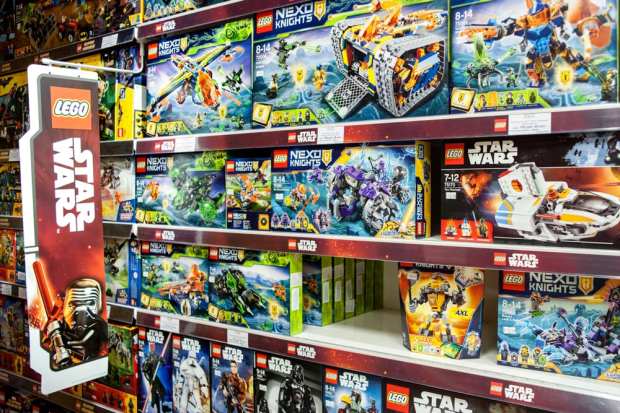May The Star Wars Merch Be With You

As you may have heard, there is a new Star Wars movie coming out in a little under a week. If you haven’t heard – well, someone in Disney’s marketing department is about to be fired, since the House Of Mouse (and superheroes, Wookiees and Jedis) has been fairly unsubtle in its attempts to make sure the entire U.S. population is aware that the final installment of the nine-part Start Wars saga will soon hit the silver screen.
And, no less important, the merchandise is on the shelves. When Disney bought the rights to Star Wars from creator George Lucas in 2013, they didn’t just get the rights to the films, characters and stories – Lucas also sold off the most valuable part of the Star Wars experience, which he’d owned for roughly 40 years: the merchandising rights.
And Disney has made good use of them.
According to analyst estimates, a Star Wars movie year is worth $5-$7 billion in merchandising revenue for Disney—and that estimate was made with the 2015 release of the first of the Disney Star Wars films, The Force Awakens.
As the retail run-up to the 2019 main event comes closer, there is every reason to think that estimate might be due for an upward revision. That’s because Star Wars merch is a bigger business than it has ever been, and a broader one to boot.
Before the holiday shopping season started, one might have guessed there would be a run on LEGO sets, lightsabers and anything with a Baby Yoda on it. But would they have predicted that Star Wars would also be a boon for purveyors of $400 -$600 pieces of cookware, or for the makers of sneakers and designer ski parkas?
We’re going to guess probably not.
But in some sense, it shouldn’t come as much of a shock. Star Wars’ nearly five-decade legacy among fans isn’t entirely due to the innovations Lucas brought to the screen – like the Millennium Falcon, lightsabers and Stormtroopers, memorable though they are.
No, a big part of the magic of Star Wars is actually in the magic of merchandising it – and Lucas’ best idea, and biggest innovation, was realizing that value long before anyone had any idea what he was talking about.
The Best $350,000 Ever Spent
Lucas was already a reasonably well-known and respected young director after the movie American Graffiti came out in 1973. He took all that success and buzz generated by his first successful film and more or less locked himself away to write the outline for a space western, and the script for the first movie in the story: Star Wars: A New Hope.
His movie studio, 20th Century Fox, didn’t really get the Star Wars project and didn’t think audiences would, either – but after some wheeling and dealing by a studio executive who was also a huge American Graffiti fan, Lucas got an $8 million budget for his movie and a $500,000 offer of payment for directing.
Lucas made what turned out to be the most brilliant counter-offer in the history of modern cinema: He offered to take a $350,000 pay cut on his director’s fee. In return, he only wanted two things: the rights to any future Star Wars sequels and the rights to all Star Wars merchandising.
The studio loved this deal. First, because they were pretty sure Star Wars was going to fail at the box office, giving Lucas the rights to sequels that would never exist. As for the merchandising rights, 20th Century Fox had been recently burned by a failed attempt to merchandise their Dr. Doolittle movie, and had thus distanced themselves from that world. Plus, who would want to buy Star Wars merchandise, anyway?
As it turned out, they were wrong on every possible count.
Between 1977 and 1978, Star Wars sold $100 million worth of toys. Over the next 35 years, those toys went on to produce $3 billion in revenue. There is also the $3.5 billion in video games, $2 billion in book sales and $1.3 billion in licensing deals. Oh, and they did end up making some sequels, so there was the additional $3.5 billion in box office returns and $4.5 billion in sales of DVDs and VHS tapes.
By the time Disney came to call in 2012, Lucas was worth $3.3 billion – roughly as rich as Oprah. After the sale to Disney, Lucas is now worth $5.5 billion (he gave a large portion of the $5 billion sale price away to charity).
Not a bad return on a $350,000 investment – though we imagine the studio executives who made the deal feel rather differently about it.
The Modern World of Star Wars Merch
As we noted, the world of Star Wars merch is now incredibly rich and varied – as are the number of retailers looking to ride the wave. It’s among the reasons Target opened Disney stores within their stores: They are banking on the dual effects of Frozen II and The Rise Of Skywalker boosting foot traffic during the highly competitive season.
It’s why regular Walmart customers have been receiving promotional emails since yesterday morning alerting them that the Star Wars merch has landed online and in stores. It’s why if you go to Amazon and search for #RiseOfTheResistance, you’ll get whisked off to a galaxy far, far away – or maybe just a secret Star Wars page featuring all the merch you could ever want for holiday 2019.
Well, maybe not all you could ever want. Because, as recent reports have noted, the first Star Wars movie came out in 1977, which means the first fans are getting older. The people who first saw A New Hope in a theater in their 20s are now in their 60s.
Think they’ve grown out of Star Wars merchandise? Think again – now they can just buy bigger, better and more expensive Star Wars merchandise. Ever thought to yourself that your Dutch oven would be more fun to use if it looked like Darth Vader? For $400, it can be yours, as can a Tatooine-themed Dutch oven. For those looking to spend a little more, there is also a signature roasting dish that features Hans Solo trapped in carbonite.
And what if you don’t have several hundred dollars to spend on Star Wars-themed kitchen items, but you do feel that you just can’t go on until something in your kitchen looks like a lovable droid? In that case, there is the R2-D2 Instant Pot, which is going for the bargain rate of $100 a pop.
We would recommend that this year’s big spenders check out the limited-edition Star Wars parkas signed by Mark Hamill, which were released this year for the staggering price of $900 apiece, but we can’t – they sold out within hours of being released on Dec. 6.
Richard Gottlieb, a toy industry consultant and founder of Global Toy Experts, said that much of today’s Star Wars merchandising boom has nothing to do with kids. The market is very crowded with other competitors in the form of princesses and superheroes (most of whom are also owned by Disney) – but it’s Baby Boomers, Gen Xers and millennials who grew up on Star Wars, and who have the money to put behind their passion.
“Star Wars is very much a nostalgia brand,” Gottlieb noted. “[Items like the parka are] an evolution in terms of marketing collectibles, geared toward a certain type of fan that has the passion and money to invest in unique items.”
And that is a passion the team is happy to indulge – and is (mostly) very good at indulging.
Mostly, but not entirely. There is, of course, the Baby Yoda misstep – proof that even after 45 years, even if you’re Disney, it is still easy to underestimate the power of the merch.
As millions of angry internet denizens already know, except for a few T-shirts, mugs and not-officially-licensed goods, Baby Yoda merchandise is basically not available this holiday season. Why? Disney didn’t want to spoil the surprise emergence of the incredibly popular character before the premiere of its Disney+ streaming network and the show The Mandalorian.
In theory, it worked: It was a big surprise.
But it seems that once again, and almost in defiance of logic at this point, Disney slightly underestimated just how popular Baby Yoda would be – and just how put off consumers of all levels of Star Wars fandom would become when they learned that Baby Yoda would not be under their tree. He is available for pre-order on the Disney website, among other places, and it seems likely that when he becomes available, he will be a big hit.
Until then, sadly, it seems Disney will just have to comfort themselves with all the merch money they will make off The Rise of Skywalker, and busy themselves stacking it all while they wait for their chance to better monetize the Mandalorian’s standout character.
Somehow, we think they’ll find a way to bear up under the strain.
